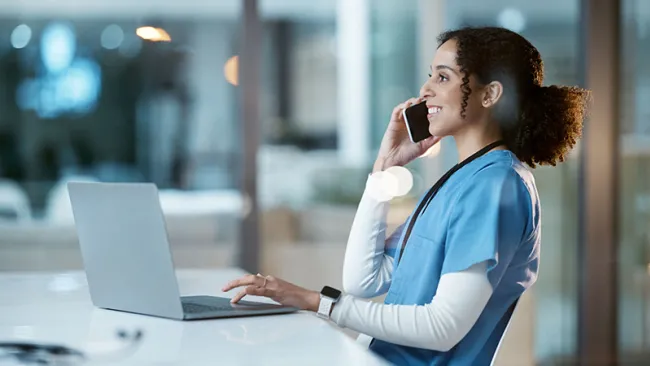Customer experiences get more complicated every day. What used to be simple customer service operations has expanded across the business with hundreds or even thousands of customer touchpoints to be managed, often by different, disconnected business units. What’s more, traditional call centers are now evolving into customer experience hubs that incorporate CRM, analytics, workforce management, omnichannel, journey orchestration, automation, social media, and the list goes on.
To keep up, new technologies arrive each day designed to improve the customer experience. There are more than 10,000 CX technology providers in a market estimated to be worth $195 billion, according to Gartner. It’s enough to overwhelm even the most seasoned customer experience professionals, especially those who rely on new technology to enable a digital transformation.
The goal of any digital transformation strategy should be to create connected, contextual conversations. Historically, this has been nearly impossible because of the numerous technologies, processes, and systems in place. APIs and other static levers that connect systems quickly become outdated and re-plumbing the organization with an entire enterprise-wide technology implementation often isn’t feasible.
Create digital-first customer experiences with a cohesive CX ecosystem
Rather than deploy disparate technologies that create siloes of digital CX, a better approach is to leverage a holistic, cohesive CX ecosystem built with innovative technology to orchestrate, integrate, automate, and operate amazing digital-first customer experiences. This environment of curated and integrated CX technologies gives senior leaders the opportunity to leverage best-of-breed platforms, applications, and capabilities without spending time and effort to research which are the best fit or how they can work together.
TTEC’s Humanify Cloud, for example, delivers a full ecosystem of pre-integrated, industry leading customer experience applications. These pre-built integrations span hundreds of apps ranging from the largest CRMs to best-in-class technology solutions across the customer lifecycle including messaging, automation, analytics, workforce management, artificial intelligence (AI), and omnichannel that TTEC fully integrates into our clients’ systems. We then add in our world-class human workforce to connect the dots between the technology and people to engage customers with speed and convenience alongside empathy, compassion, and understanding.
Companies can take advantage of a cohesive ecosystem to deploy customer journey strategy with a real-time technology layer placed on top of existing systems. This layer creates a virtual glue that enables customer-centric connectivity across the enterprise. Here’s how to harness its power to enable digital transformation in the contact center
5 steps to a successful digital transformation and customer experience technology solution
Digital transformation is a mammoth undertaking. For established complex legacy businesses, we recommend starting in the contact center, often the epicenter of all that is causing friction in the customer experience (and likely cost the most to the business), then expanding to other customer-facing functions.
In most cases, there are five steps to enable end-to-end digital transformation that improves customer satisfaction, reduces cost, and increases revenue:
1. Build journeys for continuous improvement
In most cases, businesses don’t control the customer journey. They control touchpoints. The key to successful digital transformation is to step back and define the optimal future-state, end-to-end member journey across business units and channels, then deploy the right strategy and technology to bring it to life.
Start by understanding which are the most critical journeys or touchpoint experiences that need improving. Rather than trying to make blanket improvements, a narrow focus can illuminate which areas will drive the most CX improvement and ROI. Which specific interactions cause the most dissatisfaction among customers and agents? What are the most common contact types, and what are the root causes of those contacts? Next, create sales and service personas of the types of customers experiencing those suboptimal operations. Personas are built from deep analytical models based on needs, behavior, and value of different customer segments for a particular interaction or experience.
With a narrow focus and personas defined, it’s then possible to design journeys to create ideal future states for those personas. CRM systems and tools such as journey maps and touchpoint analysis are important, but they show historical information and artifacts at a singular point in time. Customer journeys are fluid and ever changing. A snapshot isn’t enough to create continuous and significant results. Business owners—those closest to the customer—should use technology that can change journeys on the fly without requiring slow and expensive IT dependency. This is where access to a comprehensive cloud-based CX ecosystem is important, where the focus is placed on the business need to be solved, not the technology itself.
2. Reduce human dependency
Automate journeys and interactions as much as possible and create an automation center of excellence to manage the transformation from human-dependent interactions to digital/customer-driven interactions. Automation can be done over any underlying legacy systems, web applications, commercial applications, virtual desktops, etc. All of this allows very fast deployments (days and hours instead of weeks or months), easy maintenance, and quick changes.
Automation can, in certain processes, fully replace humans (what usually is known as RPA or unattended automation). This is frequent for back-office processes where the level of automation can reach 100%. But in front-office contact centers or customer-facing outlets, cases, automation will not fully replace humans. Rather, it will assist and guide them through the process. This is the function of RDA (Desktop Automation or attended automation) where humans are still needed for some customer interactions. Instead of having them focused on dealing with systems and processes, thanks to automation humans can focus just on listening, providing great service, and increasing customer satisfaction.
3. Enable a channel-less customer journey
As journeys are defined, use the enterprise workflow platform to expose the same journey to each channel of interest. Activate channel-less journeys through a workflow platform that sits above the business units and legacy platforms. Triggers and actions can be automated or semi-automated to enable seamless experiences that don't take years to build. Being able to expose the journey to any channel doesn’t only enrich each channel’s capabilities, but it also allows you to meet customer expectations on being able to move from one to another within the same journey.
Organizations can then monitor real-time customer behavior and automatically map individual journeys by need, tying back to digital touchpoints, customer records, interaction history, pain points, and other relevant voice of the customer data regardless of channel or even business unit.
4. Add Intelligence
At this stage, virtual assistants using AI and natural language processing (NLP) can further optimize interactions. This significantly increases the self-service and digital channel capacity to serve customers. Email assistants, chatbots, and advanced IVR technology can now perform any task required to create more convenient and optimized conversations.
5. Continuously Add Value
Customer support and digital experiences are ever evolving. Enable improved experiences through journey monitoring and predictive analytics along with AI-enabled journey orchestration. Using AI over all the big data coming from the automated journeys and all the channels they are exposed to allows organizations to make decisions in real time, based on what’s best for individual customers. The technology acts as a central brain that determines the best action for that specific member with every interaction and touchpoint. Share this insight with digital teams as well as human agents to inform CX improvements and collect associate insight as well to balance lessons from both automated and non-automated interactions.
At this stage, journeys don’t need to be only reactive. They can also be proactive and take initiatives to achieve business targets and increase CX, reducing effort from the customer.
At all steps in the process, it’s important to measure success from both operational and customer perspectives. Ideal metrics measure the impact of a cohesive ecosystem on the overall customer experience, not just how well each individual digital technology performs. Key data metrics include:
• Cost to serve
• Backlog reduction
• Productivity
• CSAT
• NPS
• Customer effort score
Getting Started with your customer experience technology strategy
Before tapping into elements of a customer experience ecosystem, it’s critical to put together a team of relevant stakeholders from multiple business units to represent integrated workstreams. Digital transformation requires participation from representatives across the organization. If it lives in the functional level, it may not realistically represent the entirety of the customer experience with your brand. To truly become a customer-obsessed organization, we recommend it be a C-level initiative.
With a team in place, it’s time to get to work. We recommend an agile operations learning lab and pilot approach that integrates business units. Determine the most relevant solutions and technologies in the ecosystem to apply, then build on successes with expansion to new tools and new customer groups. The result will be better, more valuable experiences for customers built on leading technologies without the need for a heavy IT lift.















